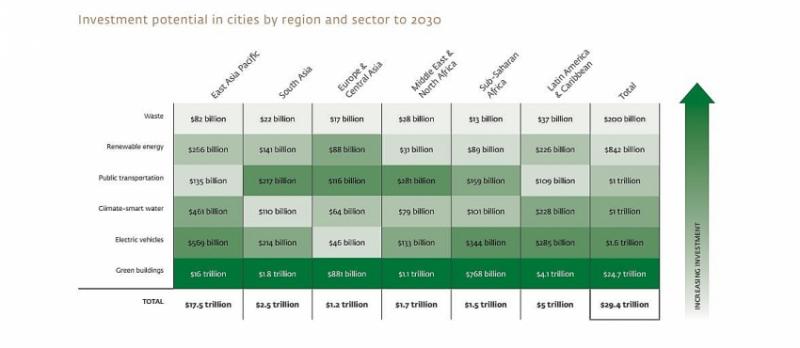Cities across Asia have the potential to attract more than USD20 trillion in climate-related investments in six key sectors by 2030, according to a new report by the International Finance Corporation (IFC). Vietnam’s climate-smart business investment potential is particularly estimated at USD753 billion.
IFC’s report entitled Climate Investment Opportunities in Cities analyses cities’ climate-related targets and action plans in six regions, identifying opportunities in priority sectors such as green buildings, public transportation, electric vehicles, waste, water, and renewable energy. It highlights the innovative approaches that cities already use – such as green bonds and public-private partnerships – to attract private capital and build urban resilience.

Investment potential in cities in East Asia-Pacific and South Asia, accordingly, are estimated at USD17.5 trillion and USD2.5 trillion across the six priority sectors, totalling USD20 trillion to 2030.
It says with its plans, policies, and projects, the Asia-Pacific region has the highest climate smart investment potential of any region in the world, with by far the biggest opportunity in green buildings, estimated at USD17.8 trillion by 2030.
With more than half of the world’s population currently living in urban areas, cities consume over two-thirds of the world’s energy and account for more than 70 per cent of global carbon dioxide emissions. How cities address climate change will be critical to efforts to limit global warming to 1.5 degrees Celsius, according to the Intergovernmental Panel on Climate Change (IPCC).
“There is a great urgency to address climate change – we must take meaningful action now,” said IFC CEO Philippe Le Houérou. “Cities are the next frontier for climate investment, with trillions of dollars in untapped opportunities. To deliver on the promise of climate-smart cities, the public sector needs to enact reforms that are aimed at attracting more private sector financing.”
“With the expected dramatic increase in urban population centres in Asia, there is even more of an opportunity for a low-carbon transition in cities, which already account for much of the GDP in this region,” said IFC regional director for East Asia and the Pacific, Vivek Pathak. “In Jakarta, there is about USD30 billion investment opportunity, particularly in green buildings, electric vehicles, and renewable energy. The report shows megacities in Asia also have significant potential for investments that yield emission reductions.”
Globally, green buildings will account for USD24.7 trillion of cities’ climate investment opportunities. Significant investment potential exists in low-carbon transportation solutions such as energy-efficient public transport (USD1 trillion) and electric vehicles (USD1.6 trillion). At the same time, clean energy (USD842 billion), water (USD1 trillion), and waste (USD200 billion) remain essential components of sustainable urban development.
In the Asia-Pacific, the report estimates the investment potential in green buildings is USD17.8 trillion, in waste USD104 billion, in public transport USD352 billion, in renewable energy USD407 billion, in climate-smart water USD571 billion, and in electric vehicles USD783 billion.
Addressing climate change is a strategic priority for IFC. Since 2005, IFC has invested USD22.2 billion in long-term financing from its own account and mobilised another USD15.7 billion through partnerships with investors for climate-related projects. The latest report is part of the Climate Investment Opportunities report series initiated by IFC in 2016.
Based on IFC’s analysis of the climate pledges made by the region’s four countries studied for this report – China, Indonesia, the Philippines, and Vietnam – the total estimated climate-smart investment potential is more than USD16 trillion by 2030. Nearly 81 per cent of this potential is construction of new green buildings in China (USD12.9 trillion) – this is the result of China’s aim to move 250 million people into cities by 2025 and is reflected in their Nationally Determined Contribution (NDC). Beyond China’s green buildings sector, the opportunity to develop the region’s urban areas is immense and is largely composed of three primary sectors: buildings, transport, and waste.
The commercial investment potential in climate-smart urban transport for the four countries is almost USD1.4 trillion, and for the municipal solid waste sector the opportunity is over USD53 billion. Construction of new green buildings is a USD345 billion opportunity in Indonesia, the Philippines, and Vietnam. Opportunities for investment in climate-smart agriculture, forestry, and land-use projects across the region are also important, but the current lack of available data for these sectors hindered IFC’s ability to produce investment estimates of sufficient quality.
Vietnam’s climate-smart business investment potential, as per IFC’s Climate Investment Opportunities in Emerging Markets report, is estimated at USD753 billion, with the majority (USD571 billion) going towards the country’s transportation infrastructure needs by 2030. Potential investment in renewable energy totals USD59 billion, with over half of this (USD31 billion) in solar photovoltaic and another USD19 billion for small hydropower projects. New green buildings represent an almost USD80 billion investment opportunity.
Source: https://www.vir.com.vn







